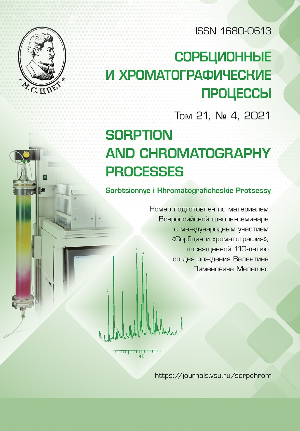Methodological aspects of determining oximes of steroid hormones by UHPLC-HRMS
Abstract
The study considers the methodological aspects of applying derivatisation of steroid hormones using hydroxylamine for further quantitative analysis of derivatives of androgens, estrogens, progestins, and glucocorticoids. It is known that hydroxylamine can significantly increase the sensitivity of mass spectrometric detection of some steroid hormones due to the formation of easily ionised oximes of steroids. What is more, the reaction for obtaining derivatives is simple.
However, alongside with the listed advantages, this method is accompanied by the formation of stereoisomers, which leads to the splitting or complete separation of the derivative peaks in chromatograms. Changing the gradient elution program does not always allow obtaining one derivative peak without affecting the efficiency and selectivity of the separation of the remaining analytes present in the sample. This makes the issue of choosing a “target” for analysis important. Determination of steroid hormones and their derivatives in biological fluids using the HPLC-MS (/MS) method with electrospray ionisation is accompanied by pronounced matrix effects. Such behaviour of substances during their chromatographic separation can be used to increase the accuracy and reliability of the results obtained due to the integration of not all peaks of derivatives, but by choosing one that is least susceptible to matrix effects caused, for example, by the coelution of sample components. This can be explained by the fact that during the reaction their isoforms are formed reproducibly, with the same yield regardless of the concentration and the matrix in which the process takes place.
The paper presents the results of the determination of some oximes of steroid hormones, considers the aspects influencing the accuracy, reproducibility, and sensitivity of the analysis on the example of determination of oximes of estrone and 11α-hydroxyprogesterone within the concentration range from 2.5
to 1000 ng/cm3. The identification of derivatives and the completeness of the reaction were controlled using standard samples of the studied compounds and high-resolution mass spectrometry. It was shown that the derivatisation procedure allows achieving a significantly higher sensitivity compared to approaches based on the direct determination of steroid hormones using HPLC-MS (/MS). If necessary, the sensitivity can be increased by the methods of preliminary concentration and purification of samples.
Downloads
References
Whirledge S., Cidlowski J.A., Physiology, Pathophysiology, and Clinical Management, 8th ed., Elsiver, 2019, Vol. 5, pp. 115-131. DOI: 10.1016/B978-0-323-47912-7.00005-6.
Cook-Botelho J.C., Bachmann L., French D., Mass Spectrometry for the Clinical Laboratory, Academic Press, 2017, Vol. 10, pp. 205-230. DOI: 10.1016/B978-0-12-800871-3.00010-9.
Keski-Rahkonen P., Huhtinen K., Poutanen M., Auriola S., J. Steroid. Biochem. Mol. Biol., 2011, Vol. 127(3-5), pp. 396-404. DOI: 10.1016/j.jsbmb.2011.06.006.
Kushnir M.M., Blamires T., Rockwood A.L., Roberts W.L. et al., Clin. Chem., 2010, Vol. 56(7), pp. 1138-1147. DOI: 10.1373/clinchem.2010.143222.
Liu Q., Chi Q., Fan R.-T., Tian H.-D. et al., Nat. Prod. Bioprospect., 2019, Vol. 9(3), pp. 201-208. DOI: 10.1007/s13659-019-0204-3.
Kushnir M.M., Rockwood A.L., Bergquist J., Varshavsky M. et al., Am. J. Clin. Pathol., 2008, Vol. 129(4), pp. 530-539. DOI: 10.1309/LC03BHQ5XJPJYEKG.
Kushnir M.M., Rockwood A.L., Roberts W.L., Pattison E.G. et al., Clin. Chem., 2006, Vol. 52(1), pp. 120-128. DOI: 10.1373/clinchem.2005.052167.
Kushnir M.M., Rockwood A.L., Roberts W.L., Pattison E.G. et al., Clin. Chem., 2006, Vol. 52(8), pp. 1559-1567. DOI: 10.1373/clinchem.2006.068445.
Nelson R.E., Grebe S.K., OKane D.J., Singh R.J., Clin Chem., 2004, Vol. 50(2), pp. 373-384. DOI: 10.1373/clinchem.2003.025478.







